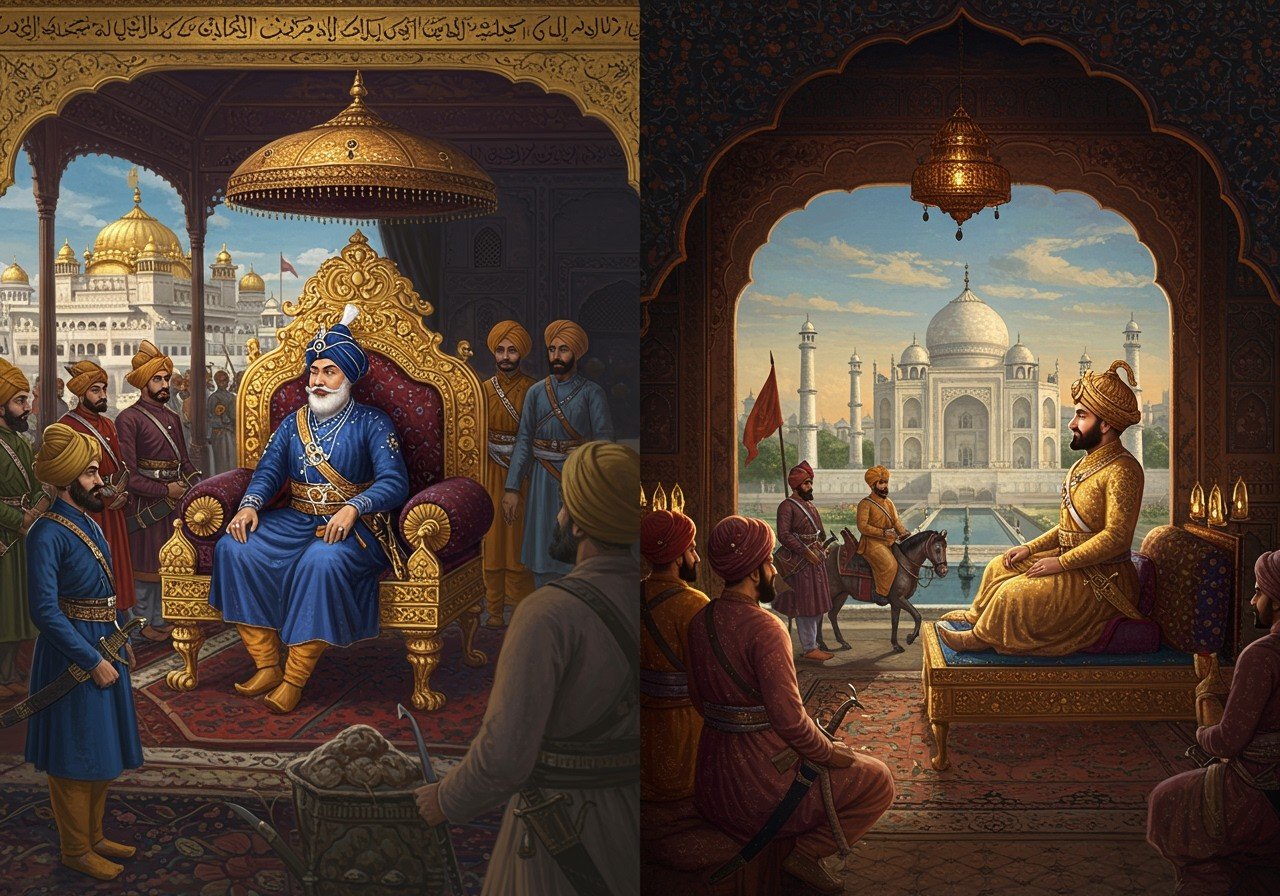
The Sikh Empire, established by Maharaja Ranjit Singh, held sway over the Punjab region from 1799 to 1849. This blog post delves into a comparative analysis of the Sikh Empire with other prominent empires of its time, including the Mughal, British, and Maratha Empires. We will explore their military strength, administrative systems, cultural achievements, and economic policies to gain a comprehensive understanding of their historical contexts.
Sikh Empire vs. Mughal Empire
Foundations and Military Strategies
The Sikh Empire, under Ranjit Singh, modernized its military with European-style artillery and a well-trained infantry. This contrasted sharply with the Mughal Empire’s reliance on traditional cavalry and time-honored warfare tactics.
Administrative Structures
The Sikh Empire employed a decentralized administrative system, granting local leaders a degree of autonomy. Conversely, the Mughal Empire maintained a highly centralized structure, with power concentrated in the hands of the emperor.
Religious Policies
While promoting Sikhism, Ranjit Singh’s empire exhibited religious tolerance, respecting other faiths. The Mughal emperors, however, varied in their religious policies, from Akbar’s inclusive approach to Aurangzeb’s stricter interpretations of Islamic law.
Cultural Contributions
The Mughal Empire is renowned for its patronage of art and architecture, exemplified by iconic structures like the Taj Mahal. The Sikh Empire, on the other hand, prioritized the preservation of Sikh heritage, exemplified by the Golden Temple.
Economic Policies
The Sikh economy was primarily agrarian. The Mughal Empire, however, boasted a more diversified revenue system encompassing trade and agriculture. Ultimately, both empires succumbed to internal strife and external pressures, including conflicts between Sikh and Mughal forces.
Sikh Empire vs. British Empire
Initial Interactions and Alliances
Initially, the Sikh Empire and the British East India Company engaged through alliances and treaties. However, this relationship deteriorated, culminating in military confrontations like the Anglo-Sikh Wars.
Administrative Approaches
The British introduced modern bureaucratic systems, supplanting the traditional governance of the Sikh Empire. This shift significantly impacted local administration and control.
Economic Impact
British colonial policies prioritized industrialization and trade, diverging from the indigenous practices of the Sikh Empire. This period also witnessed cultural exchanges, as the British documented and studied Sikh customs.
Legacy
Following annexation, Sikh soldiers became integral to the British Indian Army. Key figures like Maharaja Ranjit Singh and British officials like Lord Dalhousie shaped this era.
Sikh Empire vs. Maratha Empire
Origins and Military Tactics
Both the Sikh and Maratha Empires arose in opposition to Mughal dominance, yet their military strategies differed significantly. The Marathas excelled in guerrilla warfare, while the Sikhs fielded disciplined regiments trained in European methods.
Administrative Systems
The Maratha’s confederate structure contrasted with the more centralized Sikh Empire, influencing their respective approaches to local governance.
Religious and Cultural Policies
The Marathas championed Hindu revivalism, while the Sikh Empire upheld Sikhism. Both empires sought to safeguard their cultural identities amidst a dynamic political landscape.
Economic Foundations
Both empires relied heavily on agrarian revenue but diverged in their trade policies. The Marathas concentrated on local trade, while the Sikhs engaged with Central Asia.
Alliances and Conflicts
During the late 18th and early 19th centuries, both empires grappled with internal divisions and external threats. Leaders like Shivaji of the Marathas and Maharaja Ranjit Singh of the Sikhs left enduring legacies.
Cultural and Religious Aspects
Distinct Cultural Identities
Under Maharaja Ranjit Singh, the preservation and promotion of Sikh culture were paramount, as evidenced by the construction of significant religious sites like the Golden Temple. This contrasts with the Mughal patronage of Islamic arts and architecture, exemplified by the Taj Mahal.
Role of Religion in Governance
The Sikh Empire integrated religious leadership with political authority, a distinct approach compared to other empires that maintained a separation between these spheres.
Military Prowess and Strategies
Advanced Weaponry and Training
The Sikh Empire’s adoption of advanced weaponry and training, often facilitated by European military advisors, set it apart from empires relying on more traditional methods.
Economic Policies and Trade
Agrarian-Based Economy
The Sikh Empire’s agrarian-based economy prioritized agricultural productivity, with trade policies playing a crucial role in its prosperity.
Poojn.in: Connecting with Heritage
At Poojn.in, we understand the significance of preserving and celebrating India’s rich cultural heritage. Explore our curated collection of authentic religious items, including:
- Brass Laddu Gopal Murti: Beautifully crafted statues of Laddu Gopal, perfect for devotion and adding a touch of tradition to your home. Available in various sizes and designs to suit your preferences.
- Sandalwood Incense Sticks: Create a serene atmosphere for prayer and meditation with our high-quality sandalwood incense sticks. Made with natural ingredients and traditional methods, these incense sticks offer a fragrant and calming experience.
- Radha Krishna Bigraha: Exquisite marble dust sculptures of Radha Krishna, ideal for worship and home décor. These intricate pieces showcase the divine love and artistry of Indian craftsmanship.
Our products are carefully sourced and crafted with respect for tradition, making them ideal for personal use or as thoughtful gifts. Visit poojn.in today to discover more.
Conclusion
This comparative analysis reveals the distinct strengths and challenges of the Sikh, Mughal, British, and Maratha Empires. Maharaja Ranjit Singh’s leadership and the Sikh Empire’s military innovations, decentralized administration, and cultural preservation stand out. The Mughal Empire’s architectural wonders, the British Empire’s modern governance, and the Maratha Empire’s guerrilla tactics offer diverse perspectives on empire-building in India. Understanding these nuances enriches our appreciation of India’s intricate history.


